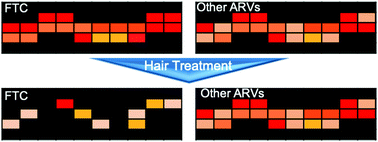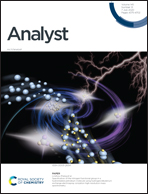Influence of hair treatments on detection of antiretrovirals by mass spectrometry imaging
Abstract
Analysis of drugs in hair by mass spectrometry imaging (MSI) has great potential as an objective, long-term measure of medication adherence. However, the fidelity of the chemical record in hair may be compromised by any cosmetic hair treatments. Here, we investigate infrared matrix-assisted laser desorption electrospray ionization (IR-MALDESI) MSI response to multiple antiretrovirals (ARVs) in cosmetically treated hair. Hair strands from patients on different ARV regimens were mechanically treated with dye, bleach, and relaxer. The treatments had little or no effect relative to untreated controls for cobicistat, abacavir, dolutegravir, maraviroc, efavirenz, and darunavir, but all three treatments removed emtricitabine (FTC) to undetectable levels from patient hair strands. We also evaluated hair strands by IR-MALDESI MSI from 8 patients on FTC-based regimens who reported a range of hair treatments at varying recency prior to hair collection. While FTC was undetectable in the treated portion of these hair strands, ARVs coadministered with FTC remained detectable in hair strands after treatment. We conclude that IR-MALDESI MSI can be used when measuring adherence to ARV therapy, provided that ARVs other than FTC are targeted in people using hair treatments.



 Please wait while we load your content...
Please wait while we load your content...